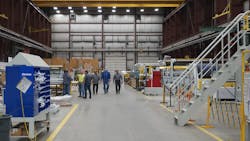Many manufacturers treat continuous improvement like free samples at Costco — tasting a little bit of this and a little bit of that to see what they like. That can lead to good results, but a risk is never buying the full portion and getting the benefits of those savings.
That was the case for century-old manufacturer Barry-Wehmiller. The St. Louis-based maker of highly engineered industrial equipment, such as box-making machines and tools for filling bottles with liquids, had lots of lean tools available to its divisions, but efforts revolved around sampling — trying a bit of this and a bit of that to solve individual problems, rather than focusing on the whole. The result: uneven gains across the 12,000-plus member strong organization.
And an opportunity to do better. Last June Doug Neal came on board as vice president of continuous improvement, a new role for the company. In announcing Neal’s appointment, Barry-Wehmiller said the new title would lead the manufacturer’s efforts to reboot its operational excellence efforts.
Eight months in, the timing seemed right to hear from Neal about how the reboot is going. In that discussion we learned about model plants, earning credibility and leaning into speed of improvement as a powerful tool for operational excellence.
Why Continuous Improvement Leadership
But first, this editor sought additional detail about what prompted the decision to introduce a new, continuous improvement-related position. It’s not as though continuous improvement is a novel idea at Barry-Wehmiller. The $3.6 billion organization has practiced lean for years, and its people-centric focus is well-documented.
Stan Blakney, a six-year-veteran of Barry-Wehmiller and group president of the manufacturer’s converting solutions platform, provided insight.
In short, operational excellence wasn’t as embedded across the organization as it could be, Blakney says. The tools of continuous improvement were, in many instances, being used on an ad hoc basis within the company. Team members would see a need, use a tool and move on, “but there [weren’t] really systematic processes to kind of guide the team on a roadmap, an improvement roadmap, and really start driving operational excellence on a whole.”
Blakney adds, “You’re moving the ball; you’re making improvements.” What was lacking “was getting things to stick.”
One particular downside of this lack of stickiness: “If you got a really good person into [a] plant, they would drive really good, lean processes, but then when that person left, there was no bench strength to keep that up.”
Talking About an Evolution
About two years ago, the company began discussions about the desire for a more formalized, systematic approach to operational excellence and business processes, one that can “live and grow and make us better going down the path,” Blakney says. (Barry-Wehmiller has more than 140 companies and 260 facilities around the globe and continues to grow. Since the start of 2024, the company has made seven acquisitions, and growth was equally robust prior to then.)
Those company discussions turned into a series of actions, beginning with the creation of a steering committee comprised of leaders from Barry-Wehmiller’s various business platforms, all of whom have experience in business systems. Blakney has a robust continuous improvement background; he became the executive sponsor and work began on developing a roadmap.
“One of the things we found early on with that steering committee is that we needed somebody to lead this … and lead from the center. And so, we started our search,” he says.
From Plans to Progress
Doug Neal came on board as vice president of continuous improvement at Barry-Wehmiller last June to lead from the center. With more than three decades of operations and continuous improvement experience, Neal most recently worked at Revvity (spun off from PerkinElmer), where his positions included senior director, global lean, and senior director, planning and logistics.
The vice president has been busy since joining Barry-Wehmiller. While the steering committee had already put things in motion and “I inherited a great plan,” Neal says, he’s been on the road and inside factories rolling out the initial phase of the transformation effort.
He started by building credibility with leaders and the workforce, meaning gaining their buy-in for the changes to come, Neal explains.
“Barry-Wehmiller has been on this journey for a long time. They've been on it and very successful at it in a lot of ways, and now we're trying to take it to that next level of having it really tie back to our business systems and really start to drive our performance, as well as engaging and enriching the lives of our team members,” he says.
“Any time you're going to try to lead an organization through some significant change, you're going to ask key people to make changes themselves, and you have to show how that's going to benefit them and their organization.”
Implementing Model Factory Sites
To that end, Barry-Wehmiller began launching model sites in the past seven months. These six locations—one in each major business division—are the initial focuses of the operational excellence efforts. The idea is to learn and gain insights from the actions and activities going on in the model plants, develop a successful framework, and ultimately spread the knowledge to other sites once certain milestones are met. (The photo at the top of this page shows one of the model sites.)
Success within these six facilities will grow the number of supportive constituents, which in turn further builds credibility for the transformation efforts, the vice president says.
Challenge of Change
Implementing change is never without its challenges. While Neal’s tenure within the Barry-Wehmiller organization is still relatively new, the company has an embedded culture. That’s largely a plus, Neal says.
“It’s one of my main talking points that I try to communicate, and that I try to get others to communicate, is that what we're creating new is how we apply things, not the things that we learn,” he says. “From a positive standpoint, we have a lot of people and a lot of infrastructure that we can leverage. We have to now guide it and steer it in different directions.”
More on Continuous Improvement at IndustryWeek
Kaizen, Lean and AI for Manufacturing Operational Excellence: Production Pulse
On the flip side, Neal says the culture also means that he has to be cautious because words matter, and “if the words are a little different, people are, ‘Oh, this is a whole new thing.’”
And when it comes to the tools of continuous improvement, that isn’t true. For example, the company is not looking to dispense with A3 problem-solving or other continuous improvement tools familiar to the workforce.
“We’re not here to change the tools. We’re here to change how we employ them and how we use them to bring our teams together and create more effective cross-functional team leadership and team effectivity,” Neal says. “It’s [about] how we deploy our goals and objectives.”
It’s also about speed. In his role, Neal is pushing to inject more speed into the organization’s continuous improvement mindset and “reignite that passion of fast fail and trying to get things done faster.”
“Faster is better than slower, so we all as a team have to recognize that speed of improvement is one of the more powerful tools,” he says.
What’s Next for Operational Excellence?
Building a formalized operational excellence system is in its early days. A lot of learning remains underway at the model sites.
“We have about five, six more months to go until we really have what we would call a well-vetted playbook to then launch other sites, so that we not only have the insights, but we also have what we would consider to be the good operating mechanisms so we can understand if things are going off the rails too quickly. And, we’re not allowing things to fester for too long without us addressing them,” Neal says.
Blakney shared a longer-term goal: Over the next three-to-five years, Barry-Wehmiller would like for key business platforms to have two or three model plants, “where they fully embrace lean and we’re running strong.”
Moreover, “We want to be a business that generates the kind of operational excellence talent that we don’t have to worry [about backsliding] if someone decides they’re going to retire. Because there’s bench strength.”
About the Author
Jill Jusko
Bio: Jill Jusko is executive editor for IndustryWeek. She has been writing about manufacturing operations leadership for more than 20 years. Her coverage spotlights companies that are in pursuit of world-class results in quality, productivity, cost and other benchmarks by implementing the latest continuous improvement and lean/Six-Sigma strategies. Jill also coordinates IndustryWeek’s Best Plants Awards Program, which annually salutes the leading manufacturing facilities in North America.
Have a story idea? Send it to [email protected].


